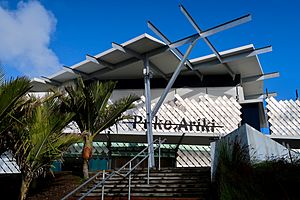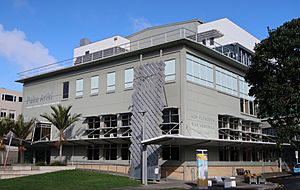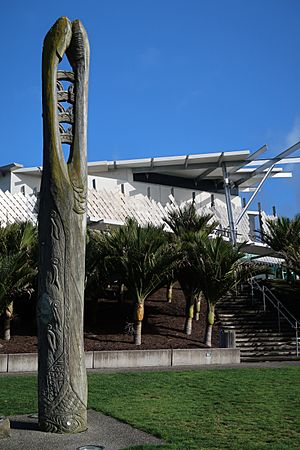Puke Ariki facts for kids

North building of Puke Ariki
|
|
| Former name | Taranaki Museum, New Plymouth Public Library |
|---|---|
| Established | 1848 (library), 1919 (museum) |
| Location | New Plymouth |
| Type | Museum, Public library |
Puke Ariki is a special place in New Plymouth, New Zealand. It's both a museum and a library, all in one building! It first opened its doors in June 2003. Puke Ariki brings together two older places: the New Plymouth Public Library, which started way back in 1848, and the Taranaki Museum, which began in 1919. The name "Puke Ariki" comes from the Māori language. It means "hill of chiefs," and it's named after an old Māori village that used to be right where the building stands today.
Contents
The Historic Puke Ariki Site
The area where Puke Ariki stands today has a long and interesting history. It was once the site of an important Māori village, or pā, belonging to the Te Āti Awa people. This pā, called Para-huka, dates back to the 1700s. It was home to a very important chief named Te Rangi-apiti-rua.
Around 1830, most of the Te Āti Awa people moved away to the Wellington region. Later, when European settlers arrived, they renamed the hill Mount Eliot. It became a place for government buildings and a signal station for ships. In the 1850s and 1860s, it was even used as a military camp for British soldiers during the First Taranaki War. Over time, much of the hill was removed to make way for railway yards, and by 1905, it was mostly gone.
How Puke Ariki Began
Puke Ariki is a combination of two older institutions: a library and a museum. Let's look at how each of them started.
The New Plymouth Public Library
The New Plymouth Public Library began in 1848 as a "Mechanics Institute and Library." It was first located in a school, then in an auction room. In 1856, it was renamed the "Literary Institute." Unfortunately, a fire in 1859 destroyed many of its books.
In 1865, the library moved into the new Town Hall building. Even though it didn't have to pay rent, it struggled with money. In 1878, the institute was officially closed, but the reading room stayed open. For a while, people had to pay to use the reading room.
Things changed in 1884 when the council decided it would be a "free public library." However, it still didn't have much money, and its books were very messy. A big improvement came in 1908 when a new library, funded by a generous gift from Andrew Carnegie, opened on King Street. The first full-time librarian was hired that same year.
The Taranaki Museum's Start
The first museum exhibits in New Plymouth were also in the Town Hall, starting in 1865. For many years, the museum, library, and reading room were seen as one big organization.
In 1895, a man named William Skinner asked the council for a special room just for the museum. In 1913, Skinner and his son offered their amazing collection of Māori artifacts and historical documents to the town. They wanted these treasures to be displayed in a safe, fireproof building that would be a "purely Taranaki museum."
Finally, an annex (an extra building) was built behind the Carnegie Library. The old exhibits from the Town Hall moved there in 1918. Skinner's collection followed in 1919. The Taranaki Museum officially opened on August 28, 1919.
By the 1930s, both the museum and library were very crowded. They needed a new, bigger home. After many years of planning, a new four-story building was approved. It would combine the library, museum, and a war memorial. This new building opened on July 14, 1960. The top floor was the War Memorial Hall, the next floor was the Taranaki Museum, and the bottom two floors were the library.
The Modern Puke Ariki Building
By the 1980s, the library and museum were once again running out of space. Planning for a much larger building, to be called Puke Ariki, began in 1993. The idea was to bring the Taranaki Museum and the public library together into one big, modern center.
The New Plymouth District Council provided a lot of money for the project, and even more funds were raised from other sources. Local architects designed the new building, which involved updating the old 1960 War Memorial building and adding a huge new museum space. The architects designed the new part to be as tall as the original Puke Ariki hill was before it was removed. The outside of the new building has a special woven wall that is 60 meters long.
Puke Ariki was officially opened by the Prime Minister Helen Clark on June 15, 2003. Eight local Māori tribes (iwi) worked together on the Puke Ariki project. They formed a special committee to help guide the project and share their ideas.
Today, the 1960 War Memorial building holds the library, archives, and research center. It connects to the new building by a walkway on the second floor. The new building houses the museum, an information center, a cafe, and a restaurant. In front of Puke Ariki, there is a carved pole (pou) from 2001 called Tukotahi/Standing Together. It shows the first meeting between Māori and European settlers in Taranaki. Puke Ariki was the biggest cultural project ever in the Taranaki region and won a special award in 2003.
Amazing Collections at Puke Ariki
Puke Ariki has many incredible collections. The first museum collections, given by William Skinner, included well-documented Māori treasures, or taonga, like a rare cloak made from dogskin. Skinner was a surveyor who traveled widely and knew many local Māori people. Today, the collections mainly include historical documents, items from local social history, Māori taonga, and a large collection of pictures.
The Motunui Panels
A very important part of the Māori taonga collection are the Motunui epa, or panels. These panels formed the back wall of a pataka, which is a Māori storehouse. Experts believe they were made by Te Āti Awa artists between 1750 and 1820. The panels were buried in a swamp near Motunui to keep them safe during tribal wars.
They were found again in 1972 and were sold to a collector who took them out of New Zealand, which was against the law. After many years of discussions and the collector's death, the New Zealand government paid a large sum of money to bring them back home. In March 2014, they were placed at Puke Ariki. They went on display in the Takapou Whariki o Taranaki gallery in October 2015.
Photographic Collection
Puke Ariki also has a huge collection of photographs. The largest part is the Swainson/Woods studios collection, which has over 111,000 negatives. These photos show everyday life from the 1920s to the 1990s. This collection was given to Puke Ariki in 2005 and was fully digitized by 2016, making it easier for people to see.
Exhibitions and Displays
Puke Ariki often hosts exciting exhibitions. One of its most popular was Bugs! Our Backyard Heroes, which ran from November 2016 to May 2017. This exhibition featured not only preserved insect specimens but also live cockroaches, stick insects, centipedes, and spiders! Bugs! attracted over 65,000 visitors and even broke the daily visitor record on January 3, 2017, with 1788 people attending.
Another notable exhibition was Hina: Celebrating Taranaki Women. This display shared the stories of 11 different women from the Taranaki region. It opened on the 125th anniversary of women's suffrage in New Zealand (when women gained the right to vote) and closed in March 2019.
See also
 In Spanish: Puke Ariki para niños
In Spanish: Puke Ariki para niños



